Speech Recognition with Pytorch using Recurrent Neural Networks
Hello, today we are going to create a neural network with Pytorch to classify the voice.

In the previous blog post we have studied this case by using Tensorflow with Convolutional Neural networks here.
This time we will use LSTM (Long Short-Term Memory) is adopted for classification, which is a type of Recurrent Neural Network.
Installation of Conda
First you need to install anaconda at this link

in this location C:\Anaconda3 , then you, check that your terminal , recognize conda
C:\conda --version
conda 4.12.0
Environment creation
The environments supported that I will consider is Python 3.7,
I will create an environment called keras, but you can put the name that you like.
conda create -n pytorch python==3.7
and then close and open the terminal
conda activate pytorch
You will have something like this:
Microsoft Windows [Version 10.0.19044.1706]
(c) Microsoft Corporation. All rights reserved.
C:\Users\ruslanmv>conda activate keras
(pytorch) C:\Users\ruslanmv>
then in your terminal type the following commands:
conda install ipykernel
then
python -m ipykernel install --user --name pytorch --display-name "Python (Pytorch)"
Then we install Pytorch, from the original source “https://pytorch.org/” we can install the one that matches with your computer.

To know the cuda version
nvcc --version
you can have see this
nvcc: NVIDIA (R) Cuda compiler driver
Copyright (c) 2005-2021 NVIDIA Corporation
Built on Wed_Jul_14_19:47:52_Pacific_Daylight_Time_2021
Cuda compilation tools, release 11.4, V11.4.100
Build cuda_11.4.r11.4/compiler.30188945_0
I’m using Stable(1,12), Windows Pip, Python 3.7, CUDA 11.3
pip3 install torch torchvision torchaudio --extra-index-url https://download.pytorch.org/whl/cu113
If you will work with Data Science Audio Projects I suggest install additional libraries:
pip install matplotlib sklearn scipy numpy jupyter opencv-python
with some audio packages
pip install librosa soundfile pynput sounddevice gtts pyttsx pyttsx3
then open the Jupyter notebook with the command
jupyter notebook&
then click New and Select your Kernel called Python (Pytorch)
And now we are ready to start working.
Recurrent neural networks
The goal of this project is to implement an audio classification system, which:
- First reads in an audio clip (containing at most one word),
- Recognizes the class(label) of this audio.
Classes
10 classes are chosen, namely:
classes=["yes", "no", "up", "down", "left", "right", "on", "off", "stop", "go"]
where “yes” means the audio contains the word “yes”, etc.
Method
Features: MFCCs (Mel-frequency cepstral coefficients) are computed from the raw audio. You can think of it as the result of fouriour transformation.
Classifier: LSTM (Long Short-Term Memory) is adopted for classificatioin, which is a type of Recurrent Neural Network.
The model was pretrained on the Speech Commands Dataset with intensive data augmentation, including “shift”, “amplify”, “superpose noise”, etc.
Sequential data
In audio and speech processing, we often deal with sequential data. A waveform is a sequence of sample points
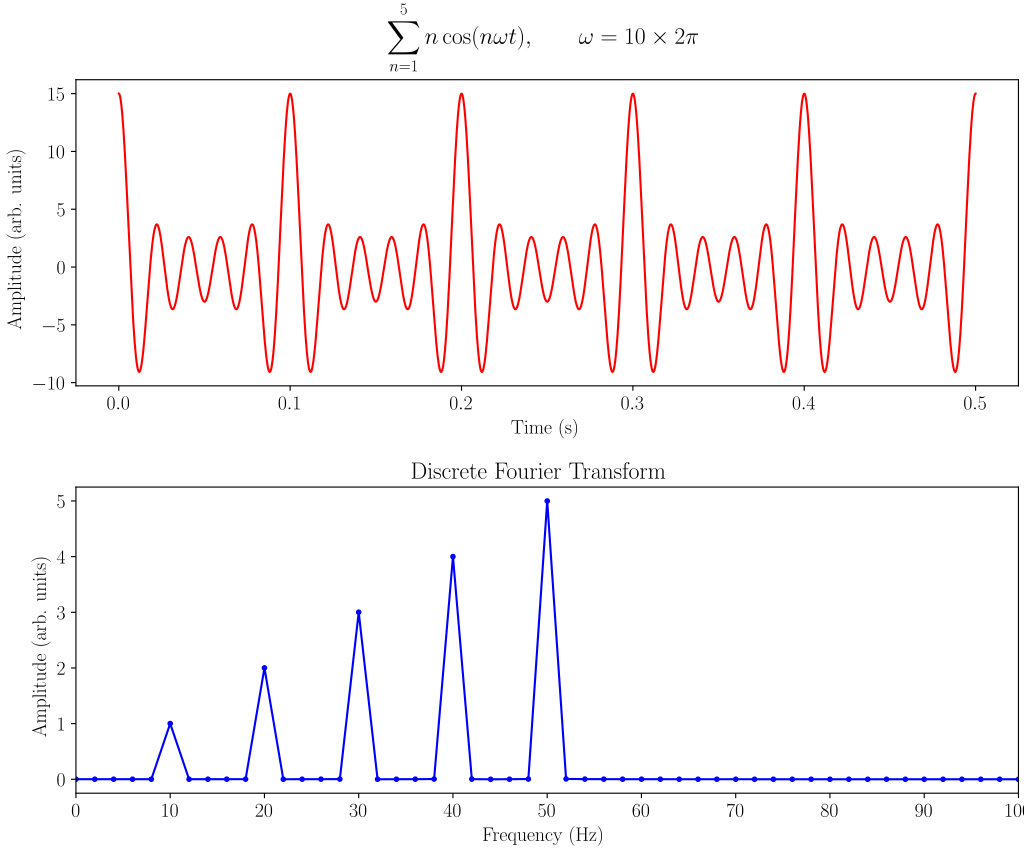
Fig. Example of a discrete Fourier analysis of a sum of cosine waves at 10, 20, 30, 40, and 50 Hz
The output of Short-time Fourier transform (STFT ) is a sequence of Fast Fourier transform (FFT) coefficients. after feature extraction, we get a sequence of acoustic features such as MFCC. Mel-frequency cepstral coefficients (MFCCs) are coefficients that collectively make up an MFC. They are derived from a type of cepstral representation of the audio clip (a nonlinear “spectrum-of-a-spectrum”).
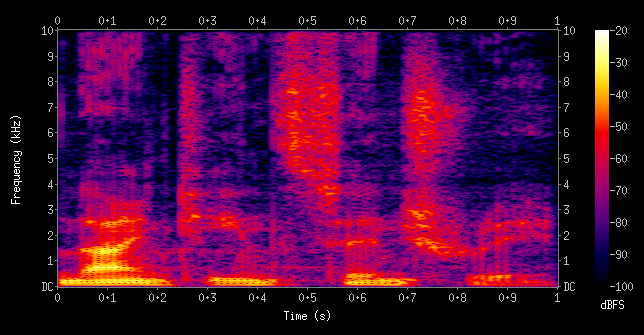
Fig. A spectrogram visualizing the results of a STFT of the words “nineteenth century”. Here frequencies are shown increasing up the vertical axis, and time on the horizontal axis. The legend to the right shows that the color intensity increases with the density.
In engineering applications, the Fourier series is generally presumed to converge almost everywhere (the exceptions being at discrete discontinuities) since the functions encountered in engineering are better-behaved than the functions that mathematicians can provide as counter-examples to this presumption.

Four partial sums (Fourier series) of lengths 1, 2, 3, and 4 terms, showing how the approximation to a square wave improves as the number of terms increases. where the Fourier transform by the integral formula

What’s special about sequential data?
It has a time dimension.
- The sequence can be long
- The length of the sequence can be unknown
- Reusing parameters
Same information can repeat at different positions in the sequence
Example of speech recognition:
• Utterance 1: “Today is a nice day.”
• Utterance 2: “What’s the weather today?”
The same word “today” appears at different positions in two utterances
The parameters to recognize the word “today” should be reused
In short, we want to make better use of temporally repeated information
Having memory
Example of speech recognition:
• Utterance 1: “What is the weather today?”
• Utterance 2: “I don’t know whether I should go.”
• The word “weather” and “whether” have the same pronunciation
• Speech recognition requires the context
• The context can be modeled via memory
The output at time 𝑡 depends on the states at time 𝑡 − 1
• The hidden states:

The output:

where:
• 𝜎ℎ ⋅ : activation function for hidden states
• 𝜎𝑦(⋅): activation function for outputs
• {𝑾ℎ, 𝑼ℎ, 𝒃ℎ,𝑾𝑦, 𝒃𝑦}: time-independent parameters
• Usually we assume 𝒉0 = 0
We will build an LSTM-based speaker recognition system from scratch.
How Does Recurrent Neural Networks Work?
In Recurrent Neural networks, the information cycles through a loop to the middle hidden layer.
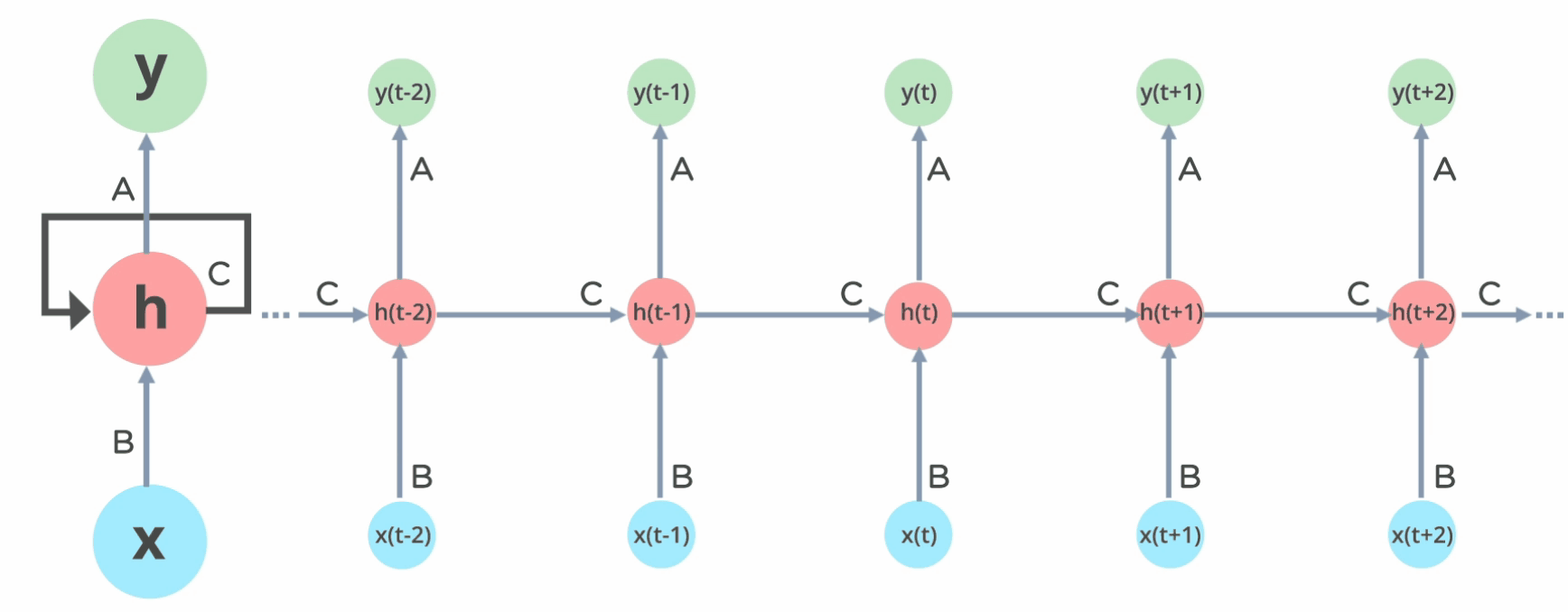
Fig: Working of Recurrent Neural Network
The input layer x takes in the input to the neural network and processes it and passes it onto the middle layer.
The middle layer h can consist of multiple hidden layers, each with its own activation functions and weights and biases. If you have a neural network where the various parameters of different hidden layers are not affected by the previous layer, ie: the neural network does not have memory, then you can use a recurrent neural network.
The Recurrent Neural Network will standardize the different activation functions and weights and biases so that each hidden layer has the same parameters. Then, instead of creating multiple hidden layers, it will create one and loop over it as many times as required.
Importing Libraries
from time import sleep
from tqdm import tqdm
import os
import urllib.request
import pathlib
import shutil
import os
import librosa
import IPython.display as ipd
import matplotlib.pyplot as plt
import numpy as np
from scipy.io import wavfile
import warnings
warnings.filterwarnings("ignore")
%load_ext autoreload
%autoreload 2
import sys, os
import time
import numpy as np
import matplotlib.pyplot as plt
import scipy
import copy
import torch
# display
import IPython.display as ipd
from IPython.core.display import HTML
from IPython.display import display, clear_output
# audio library
import librosa.display
import shutil
Step 2 Creation of some utility programs
We define some functions that allow us download the datasets that we need to use to create our ML model and train it.
class DownloadProgressBar(tqdm):
def update_to(self, b=1, bsize=1, tsize=None):
if tsize is not None:
self.total = tsize
self.update(b * bsize - self.n)
def download_file(url, output_path):
with DownloadProgressBar(unit='B', unit_scale=True,
miniters=1, desc=url.split('/')[-1]) as t:
urllib.request.urlretrieve(
url, filename=output_path, reporthook=t.update_to)
Speech Commands Dataset
Speech Commands Dataset contains 105k audio clips (3.3GB large) collected from lots of people.
It has 35 classes of words, listed as follows:
# We define some parameters
# current working directory
DIR = os.path.abspath(os.getcwd())
DATASET_DIRECTORY_PATH = DIR+'/data/speech_commands'
#DOWNLOAD_URL = 'http://download.tensorflow.org/data/speech_commands_v0.02.tar.gz'
DOWNLOAD_URL = "http://download.tensorflow.org/data/speech_commands_v0.01.tar.gz"
Downloading the data and Unzip the tar file
# Check if dataset directory already exist, otherwise download, extract and remove the archive
if not os.path.isdir(DATASET_DIRECTORY_PATH):
if not os.path.isdir(DIR+'/data'):
os.mkdir(DIR+'/data')
print('Downloading from ' + DOWNLOAD_URL)
download_file(DOWNLOAD_URL, DIR+'/data/speech_commands.tar.gz')
print("Extracting archive...")
shutil.unpack_archive(
DIR+'/data/speech_commands.tar.gz', DATASET_DIRECTORY_PATH)
os.remove(DIR+'/data/speech_commands.tar.gz')
print("Done.")
Downloading from http://download.tensorflow.org/data/speech_commands_v0.01.tar.gz
speech_commands_v0.01.tar.gz: 1.49GB [01:27, 17.0MB/s]
Extracting archive...
Done.
# Delete the extra files of extracted file
# Cleaning data
if os.name == 'nt':
print("We are on Windows")
paths=DIR+'\data\speech_commands'
os.chdir(paths)
files=['testing_list.txt','validation_list.txt','LICENSE','README.md']
for f in files:
try:
os.remove(f)
except FileNotFoundError:
continue
#!dir
os.chdir(DIR)
else:
print("We are on Unix")
extras=DIR+'/data/speech_commands/*.*'
command='rm -rf '+ extras
os.system(command)
extras=DIR+'/data/speech_commands/LICENSE'
command='rm -rf '+ extras
os.system(command)
#!ls ./data/speech_commands
We are on Windows
train_audio_path =DATASET_DIRECTORY_PATH+"/"
# Number of recording of each voices
labels = os.listdir(train_audio_path)
print(labels)
['bed', 'bird', 'cat', 'dog', 'down', 'eight', 'five', 'four', 'go', 'happy', 'house', 'left', 'marvin', 'nine', 'no', 'off', 'on', 'one', 'right', 'seven', 'sheila', 'six', 'stop', 'three', 'tree', 'two', 'up', 'wow', 'yes', 'zero', '_background_noise_']
to_remove = [x for x in labels if x not in classes]
len(to_remove)
21
print(to_remove)
['bed', 'bird', 'cat', 'dog', 'eight', 'five', 'four', 'happy', 'house', 'marvin', 'nine', 'one', 'seven', 'sheila', 'six', 'three', 'tree', 'two', 'wow', 'zero', '_background_noise_']
for directory in to_remove:
noise_dir_new=DIR+'/data/'+directory
noise_dir_old=DIR+'/data/speech_commands/'+directory
try:
shutil.move(noise_dir_old, noise_dir_new)
except FileNotFoundError as e:
pass #folder doesn't exist, deal with it.
# Number of recording of each voices
labels = os.listdir(train_audio_path)
print(labels)
['down', 'go', 'left', 'no', 'off', 'on', 'right', 'stop', 'up', 'yes']
WORK_DIR =['data_train','checkpoints']
for DIRECTORY in WORK_DIR:
WORK_DIRECTORY_PATH = DIR +'/'+ DIRECTORY
if not os.path.isdir(WORK_DIRECTORY_PATH):
if not os.path.isdir(DIR+'/'+DIRECTORY ):
os.mkdir(DIR+'/'+DIRECTORY )
CONFIG_DIRECTORY_PATH = DIR+'/config'
# Check if config directory already exist, otherwise will create
import os
import shutil
if not os.path.isdir(CONFIG_DIRECTORY_PATH):
if not os.path.isdir(DIR+'/config'):
os.mkdir(DIR+'/config')
print('Creating config')
# list of names
names = labels
# open file in write mode
with open(r'config/classes.names', 'w') as fp:
for item in names:
# write each item on a new line
fp.write("%s\n" % item)
print("Done.")
Creating config
Done.
Downloading the utils and installing
LIB_DIRECTORY_PATH = DIR+'/utils'
# Check if utils directory already exist, otherwise download, and install
import os
import shutil
if not os.path.isdir(LIB_DIRECTORY_PATH):
if not os.path.isdir(DIR+'/utils'):
os.mkdir(DIR+'/utils')
print('Downloading utils')
user = "ruslanmv"
repo = "Speech-Recognition-with-RNN-Neural-Networks"
src_dir = "utils"
pyfile = "lib.py"
url = f"https://raw.githubusercontent.com/{user}/{repo}/master/{src_dir}/{pyfile}"
!wget --no-cache --backups=1 {url}
print("Installing library...")
shutil.move(DIR+'/lib.py', DIR +'/utils/lib.py')
print("Done.")
try:
import gtts
except ImportError as e:
!pip install gtts
pass # module doesn't exist, deal with it.
# Import all libraries
import utils.lib as lib
3. Methods
3.1. Training data
These large amount of data are important for extracting the core features of a word.
If I didn’t do the pretraining on this dataset, the model will have poor performance when generalizing to other people’s voices.
3.1.2. My dataset
We choose 10 target classes listed as follows:
# Number of recording of each voices
labels = os.listdir(train_audio_path)
print(labels)
['down', 'go', 'left', 'no', 'off', 'on', 'right', 'stop', 'up', 'yes']
len(labels)
10
labels=os.listdir(train_audio_path)
#find count of each label and plot bar graph
no_of_recordings=[]
for label in labels:
waves = [f for f in os.listdir(train_audio_path + label) if f.endswith('.wav')]
no_of_recordings.append(len(waves))
#plot
plt.figure(figsize=(30,5))
index = np.arange(len(labels))
plt.bar(index, no_of_recordings)
plt.xlabel('Commands', fontsize=12)
plt.ylabel('No of recordings', fontsize=12)
plt.xticks(index, labels, fontsize=15, rotation=60)
plt.title('No. of recordings for each command')
plt.show()

#Load the audio file
if os.name == 'nt':
print("We are on Windows")
test_file=train_audio_path+'left/00b01445_nohash_0.wav'
audio = lib.AudioClass(filename=test_file)
else:
print("We are on Unix")
test_file=train_audio_path+'left/00b01445_nohash_0.wav'
audio = lib.AudioClass(filename=test_file)
We are on Windows
ipd.Audio(audio.data, rate=audio.sample_rate) # play audio
3.2. Data augmentation
Raw data goes through a serials of augmentation before training, including:
Shift
Pad zeros
Amplify
Change play speed
Superpose noise
This step is essential. Raw audios in Speech Commands Dataset are all about 1 second long, and have little background noise. It can easily causes certain overfitting.
We should try to diversify the data by data augmentation techniques, in order to get prepared for all kinds of real-world scenarios, including noise, variation of the audio length and loudness.
We need detect the perturbation. Which part of audio do we feed an speaker recognition input? Well given by the Text-dependent: keyword/wakeword detection or the Text-independent: voice activity detection (VAD)

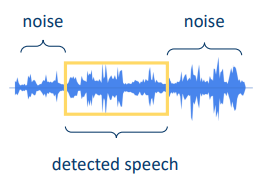
For this classification we keep the most simple as possible.
Example of audio augmentation:
# Initialize the augmenter.
# Specify a parameter's range for generating a random augmentation.
Aug = lib.Augmenter
aug = Aug([
Aug.Shift(rate=(0, 0.2), keep_size=False), # shift data for 0~0.2 percent of the total length
Aug.PadZeros(time=(0, 0.3)), # pad zeros at one side for 0~0.3 seconds
Aug.Amplify(rate=(0.2, 1.5)), # amplify loudness by 0.2~1.5
Aug.PlaySpeed(rate=(0.7, 1.3), keep_size=False), # change play speed
Aug.Noise( # Superpose noise.
# (Noise files are pre-load and normalized)
noise_folder="data/_background_noise_/", prob_noise=1.0, intensity=(0, 0.7)),
], prob_to_aug=1.0, # probability to do this augmentation
)
# Read audio, do two different augmentations, and plot results
plt.figure(figsize=(16, 5))
plt.subplot(131)
audio_1 = lib.AudioClass(filename=test_file)
audio_1.plot_audio(ax=plt.gca())
plt.title("Raw audio")
plt.subplot(132)
audio_2 = copy.deepcopy(audio_1)
aug(audio_2) # augment audio
audio_2.plot_audio(ax=plt.gca())
plt.title("Augmentation 1")
plt.subplot(133)
audio_3 = copy.deepcopy(audio_1)
aug(audio_3) # augment audio
audio_3.plot_audio(ax=plt.gca())
plt.title("Augmentation 2")
plt.show()
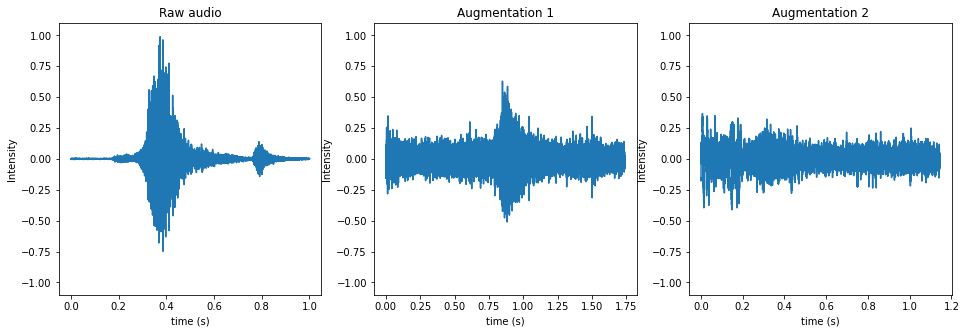
ipd.Audio(audio_1.data, rate=audio_1.sample_rate) # play audio
ipd.Audio(audio_2.data, rate=audio_2.sample_rate)
ipd.Audio(audio_3.data, rate=audio_3.sample_rate)
Noise files for audio augmentation:
audio_noise = lib.AudioClass(filename="data/_background_noise_/doing_the_dishes.wav")
ipd.Audio(audio_noise.data, rate=audio_noise.sample_rate) # play audio
3.3. Features
The MFCCs feature is computed and fed into the classifer.
An intuitive understanding of MFCCs is: Use a sliding window on the raw data, and compute the fourior transform of each window to obtain the “loudness” on each frequency band.
The code and parameters for computing MFCCs is:
def compute_mfcc(data, sample_rate, n_mfcc=12):
return librosa.feature.mfcc(y=data, sr=sample_rate, n_mfcc=n_mfcc)
# A visualization of the MFCCs features is shown below:
audio.compute_mfcc()
audio.plot_audio_and_mfcc()
plt.show()
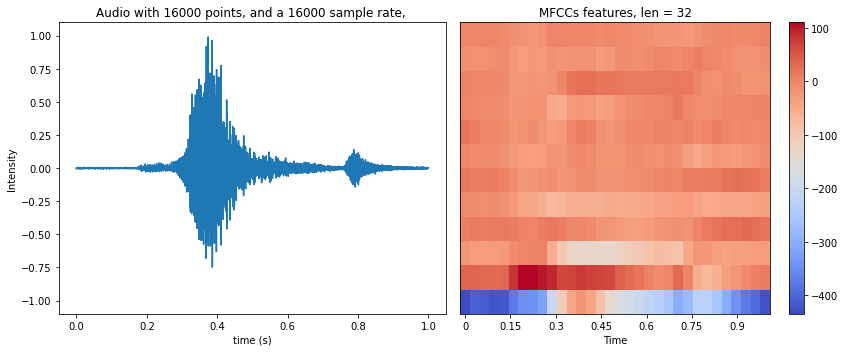
- Histogram of MFCCs is a bad feature
I also tested the feature of “the histogram of MFCCs”, but the performance is bad, since the information of time length is lost.
A histogram feature is shown below. It’s computed piece-wisely of 3 pieces on a MFCCs:
audio.compute_mfcc_histogram(bins=10, binrange=(-50, 200), col_divides=3)
audio.plot_mfcc_histogram() # After experiment, I found that this feature is bad. Don't use it.
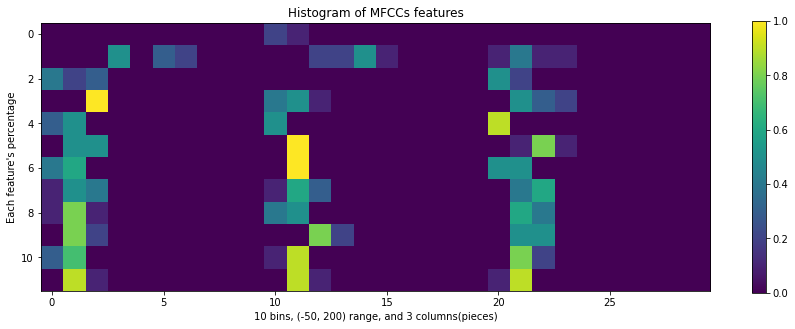
3.4. Classifier
The input audio has a varying length, thus the feature’s length also varies.
To deal with such cases, I adopted the LSTM (Long short-term memory) for classification.
The main paramters are set as: 3 layers and 64 states in each layer.
The code is copied from here.
import sys, os
ROOT=DATASET_DIRECTORY_PATH
sys.path.append(ROOT)
import numpy as np
import torch
import numpy as np
import time
import types
import matplotlib.pyplot as plt
import torch
import torch.nn as nn
import torchvision
import torchvision.transforms as transforms
from torch.utils.data import Dataset
def set_default_args():
args = types.SimpleNamespace()
# model params
args.input_size = 12 # == n_mfcc
args.batch_size = 1
args.hidden_size = 64
args.num_layers = 3
# training params
args.num_epochs = 100
args.learning_rate = 0.0001
args.learning_rate_decay_interval = 5 # decay for every 5 epochs
args.learning_rate_decay_rate = 0.5 # lr = lr * rate
args.weight_decay = 0.00
args.gradient_accumulations = 16 # number of gradient accums before step
# training params2
args.load_weights_from = None
args.finetune_model = False # If true, fix all parameters except the fc layer
args.device = torch.device('cuda' if torch.cuda.is_available() else 'cpu')
# data
args.data_folder = "data/data_train/"
args.train_eval_test_ratio=[0.9, 0.1, 0.0]
args.do_data_augment = False
# labels
#args.classes_txt = "config/classes.names"
args.classes_txt =labels
args.num_classes = None # should be added with a value somewhere, like this:
# = len(lib.read_list(args.classes_txt))
# log setting
args.plot_accu = True # if true, plot accuracy for every epoch
args.show_plotted_accu = False # if false, not calling plt.show(), so drawing figure in background
args.save_model_to = 'checkpoints/' # Save model and log file
#e.g: model_001.ckpt, log.txt, log.jpg
return args
def load_weights(model, weights, PRINT=False):
# Load weights into model.
# If param's name is different, raise error.
# If param's size is different, skip this param.
# see: https://discuss.pytorch.org/t/how-to-load-part-of-pre-trained-model/1113/2
for i, (name, param) in enumerate(weights.items()):
model_state = model.state_dict()
if name not in model_state:
print("-"*80)
print("weights name:", name)
print("RNN states names:", model_state.keys())
assert 0, "Wrong weights file"
model_shape = model_state[name].shape
if model_shape != param.shape:
print(f"\nWarning: Size of {name} layer is different between model and weights. Not copy parameters.")
print(f"\tModel shape = {model_shape}, weights' shape = {param.shape}.")
else:
model_state[name].copy_(param)
def create_RNN_model(args, load_weights_from=None):
''' A wrapper for creating a 'class RNN' instance '''
# Update some dependent args
#args.num_classes = len(lib.read_list(args.classes_txt)) # read from "config/classes.names"
args.num_classes = len(labels) # read from "config/classes.names"
args.save_log_to = args.save_model_to + "log.txt"
args.save_fig_to = args.save_model_to + "fig.jpg"
# Create model
device = args.device
model = RNN(args.input_size, args.hidden_size, args.num_layers, args.num_classes, device).to(device)
# Load weights
if load_weights_from:
print(f"Load weights from: {load_weights_from}")
weights = torch.load(load_weights_from)
load_weights(model, weights)
return model
# Recurrent neural network (many-to-one)
class RNN(nn.Module):
def __init__(self, input_size, hidden_size, num_layers, num_classes, device, classes=None):
super(RNN, self).__init__()
self.hidden_size = hidden_size
self.num_layers = num_layers
self.lstm = nn.LSTM(input_size, hidden_size, num_layers, batch_first=True)
self.fc = nn.Linear(hidden_size, num_classes)
self.device = device
self.classes = classes
def forward(self, x):
# Set initial hidden and cell states
batch_size = x.size(0)
h0 = torch.zeros(self.num_layers, batch_size, self.hidden_size).to(self.device)
c0 = torch.zeros(self.num_layers, batch_size, self.hidden_size).to(self.device)
# Forward propagate LSTM
out, _ = self.lstm(x, (h0, c0)) # shape = (batch_size, seq_length, hidden_size)
# Decode the hidden state of the last time step
out = self.fc(out[:, -1, :])
return out
def predict(self, x):
'''Predict one label from one sample's features'''
# x: feature from a sample, LxN
# L is length of sequency
# N is feature dimension
x = torch.tensor(x[np.newaxis, :], dtype=torch.float32)
x = x.to(self.device)
outputs = self.forward(x)
_, predicted = torch.max(outputs.data, 1)
predicted_index = predicted.item()
return predicted_index
def set_classes(self, classes):
self.classes = classes
def predict_audio_label(self, audio):
idx = self.predict_audio_label_index(audio)
assert self.classes, "Classes names are not set. Don't know what audio label is"
label = self.classes[idx]
return label
def predict_audio_label_index(self, audio):
audio.compute_mfcc()
x = audio.mfcc.T # (time_len, feature_dimension)
idx = self.predict(x)
return idx
def evaluate_model(model, eval_loader, num_to_eval=-1):
''' Eval model on a dataset '''
device = model.device
correct = 0
total = 0
for i, (featuress, labels) in enumerate(eval_loader):
featuress = featuress.to(device) # (batch, seq_len, input_size)
labels = labels.to(device)
# Predict
outputs = model(featuress)
_, predicted = torch.max(outputs.data, 1)
total += labels.size(0)
correct += (predicted == labels).sum().item()
# stop
if i+1 == num_to_eval:
break
eval_accu = correct / total
print(' Evaluate on eval or test dataset with {} samples: Accuracy = {}%'.format(
i+1, 100 * eval_accu))
return eval_accu
def fix_weights_except_fc(model):
not_fix = "fc"
for name, param in model.state_dict().items():
if not_fix in name:
continue
else:
print(f"Fix {name} layer", end='. ')
param.requires_grad = False
print("")
def train_model(model, args, train_loader, eval_loader):
device = model.device
logger = lib.TrainingLog(training_args=args)
if args.finetune_model:
fix_weights_except_fc(model)
# -- create folder for saving model
if args.save_model_to:
if not os.path.exists(args.save_model_to):
os.makedirs(args.save_model_to)
# -- Loss and optimizer
criterion = nn.CrossEntropyLoss()
optimizer = torch.optim.Adam(model.parameters(), lr=args.learning_rate, weight_decay=args.weight_decay)
optimizer.zero_grad()
# -- For updating learning rate
def update_lr(optimizer, lr):
for param_group in optimizer.param_groups:
param_group['lr'] = lr
# -- Train the model
total_step = len(train_loader)
curr_lr = args.learning_rate
cnt_batches = 0
for epoch in range(1, 1+args.num_epochs):
cnt_correct, cnt_total = 0, 0
for i, (featuress, labels) in enumerate(train_loader):
cnt_batches += 1
''' original code of pytorch-tutorial:
images = images.reshape(-1, sequence_length, input_size).to(device)
labels = labels.to(device)
# we can see that the shape of images should be:
# (batch_size, sequence_length, input_size)
'''
featuress = featuress.to(device)
labels = labels.to(device)
# Forward pass
outputs = model(featuress)
loss = criterion(outputs, labels)
# Backward and optimize
loss.backward() # error
if cnt_batches % args.gradient_accumulations == 0:
# Accumulates gradient before each step
optimizer.step()
optimizer.zero_grad()
# Record result
_, argmax = torch.max(outputs, 1)
cnt_correct += (labels == argmax.squeeze()).sum().item()
cnt_total += labels.size(0)
# Print accuracy
train_accu = cnt_correct/cnt_total
if (i+1) % 50 == 0 or (i+1) == len(train_loader):
print ('Epoch [{}/{}], Step [{}/{}], Loss = {:.4f}, Train accuracy = {:.2f}'
.format(epoch, args.num_epochs, i+1, total_step, loss.item(), 100*train_accu))
continue
print(f"Epoch {epoch} completes")
# -- Decay learning rate
if (epoch) % args.learning_rate_decay_interval == 0:
curr_lr *= args.learning_rate_decay_rate # lr = lr * rate
update_lr(optimizer, curr_lr)
# -- Evaluate and save model
if (epoch) % 1 == 0 or (epoch) == args.num_epochs:
eval_accu = evaluate_model(model, eval_loader, num_to_eval=-1)
if args.save_model_to:
name_to_save = args.save_model_to + "/" + "{:03d}".format(epoch) + ".ckpt"
torch.save(model.state_dict(), name_to_save)
print("Save model to: ", name_to_save)
# logger record
logger.store_accuracy(epoch, train=train_accu, eval=eval_accu)
logger.save_log(args.save_log_to)
# logger Plot
if args.plot_accu and epoch == 1:
plt.figure(figsize=(10, 8))
plt.ion()
if args.show_plotted_accu:
plt.show()
if (epoch == args.num_epochs) or (args.plot_accu and epoch>1):
logger.plot_train_eval_accuracy()
if args.show_plotted_accu:
plt.pause(0.01)
plt.savefig(fname=args.save_fig_to)
# An epoch end
print("-"*80 + "\n")
# Training end
return
# Set arguments -------------------------
args = set_default_args()
args.learning_rate = 0.001
args.num_epochs = 25
args.learning_rate_decay_interval = 5 # decay for every 3 epochs
args.learning_rate_decay_rate = 0.5 # lr = lr * rate
args.do_data_augment = True
args.train_eval_test_ratio=[0.9, 0.1, 0.0]
# current working directory
DIR = os.path.abspath(os.getcwd())
DATASET_DIRECTORY_PATH = DIR+'/data/speech_commands'
args.data_folder = "data/speech_commands/"
args.classes_txt = "config/classes.names"
args.load_weights_from = None
# Dataset --------------------------
# Get data's filenames and labels
files_name, files_label = lib.AudioDataset.load_filenames_and_labels(
args.data_folder, args.classes_txt)
Load data from: data/speech_commands/
Classes: down, go, left, no, off, on, right, stop, up, yes
DEBUG = False
# DEBUG: use only a subset of all data
if DEBUG == True:
GAP = 1000
files_name = files_name[::GAP]
files_label = files_label[::GAP]
args.num_epochs = 5
print('We consider subset of dataset')
else:
print('We consider the full dataset')
We consider the full dataset
# Set data augmentation
if args.do_data_augment:
Aug = lib.Augmenter # rename
aug = Aug([
Aug.Shift(rate=0.2, keep_size=False),
Aug.PadZeros(time=(0, 0.3)),
Aug.Amplify(rate=(0.2, 1.5)),
# Aug.PlaySpeed(rate=(0.7, 1.3), keep_size=False),
Aug.Noise(noise_folder="data/_background_noise_/",
prob_noise=0.7, intensity=(0, 0.7)),
], prob_to_aug=0.8)
else:
aug = None
# Split data into train/eval/test
tr_X, tr_Y, ev_X, ev_Y, te_X, te_Y = lib.split_train_eval_test(
X=files_name, Y=files_label, ratios=args.train_eval_test_ratio, dtype='list')
train_dataset = lib.AudioDataset(files_name=tr_X, files_label=tr_Y, transform=aug)
eval_dataset = lib.AudioDataset(files_name=ev_X, files_label=ev_Y, transform=None)
Split data into [Train=21313 (90.0%), Eval=2369 (10.0%), Test=0 (0.0%)]
len(tr_X),len(tr_Y)
(21313, 21313)
len(ev_X),len( ev_Y )
(2369, 2369)
# Data loader
train_loader = torch.utils.data.DataLoader(dataset=train_dataset, batch_size=args.batch_size, shuffle=True)
eval_loader = torch.utils.data.DataLoader(dataset=eval_dataset, batch_size=args.batch_size, shuffle=True)
print(torch.cuda.device_count())
1
print(torch.cuda.get_device_name(0))
NVIDIA GeForce RTX 2070 with Max-Q Design
cuda0 = torch.device('cuda:0')
device = torch.device('cuda' if torch.cuda.is_available() else 'cpu')
# Create model and train -------------------------------------------------
model = create_RNN_model(args, load_weights_from=args.load_weights_from) # create model
train_model(model, args, train_loader, eval_loader)
Epoch [25/25], Step [21100/21313], Loss = 0.0057, Train accuracy = 84.35
Epoch [25/25], Step [21150/21313], Loss = 0.0038, Train accuracy = 84.35
Epoch [25/25], Step [21200/21313], Loss = 0.0014, Train accuracy = 84.33
Epoch [25/25], Step [21250/21313], Loss = 0.6493, Train accuracy = 84.34
Epoch [25/25], Step [21300/21313], Loss = 1.1103, Train accuracy = 84.34
Epoch [25/25], Step [21313/21313], Loss = 0.0007, Train accuracy = 84.33
Epoch 25 completes
Evaluate on eval or test dataset with 2369 samples: Accuracy = 92.35964542000843%
Save model to: checkpoints//025.ckpt
--------------------------------------------------------------------------------
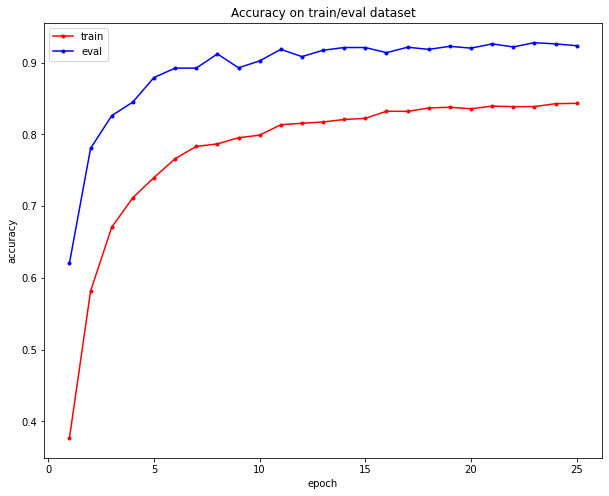
4. Test
Let’s test the model on an audio file:
# Load model
def setup_classifier(load_weights_from):
model_args = set_default_args()
device = torch.device('cuda' if torch.cuda.is_available() else 'cpu')
model = create_RNN_model(model_args, load_weights_from)
return model
def setup_classes_labels(load_classes_from, model):
classes = lib.read_list(load_classes_from)
print(f"{len(classes)} classes: {classes}")
model.set_classes(classes)
model = setup_classifier(load_weights_from="checkpoints//025.ckpt")
setup_classes_labels(load_classes_from="config/classes.names", model=model)
Load weights from: checkpoints//025.ckpt
10 classes: ['down', 'go', 'left', 'no', 'off', 'on', 'right', 'stop', 'up', 'yes']
#Load test audio file
if os.name == 'nt':
print("We are on Windows")
test_file= ev_X[0]
audio = lib.AudioClass(filename=test_file)
else:
print("We are on Unix")
test_file=ev_X[0]
audio = lib.AudioClass(filename=test_file)
We are on Windows
# Test on an audio
ipd.Audio(audio.data, rate=audio.sample_rate) # play audio
# Test on an audio
model.predict_audio_label(audio)
'yes'
label = model.predict_audio_label(audio)
print(f"Predicted label is: {label}")
Predicted label is: yes
Predictions on the validation data:
import matplotlib.pyplot as plt
import numpy
from sklearn import metrics
y_pred = []
y_true = []
for i in range(len(ev_X)):
audio = lib.AudioClass(filename=ev_X[i])
prediction=model.predict_audio_label(audio)
y_pred.append(prediction)
real=labels[ev_Y[i]]
y_true.append(real)
# converting list to array
actual = numpy.array(y_true)
predicted = numpy.array(y_pred)
confusion_matrix = metrics.confusion_matrix(actual, predicted)
cm_display = metrics.ConfusionMatrixDisplay(confusion_matrix = confusion_matrix, display_labels = labels)
cm_display.plot()
plt.show()
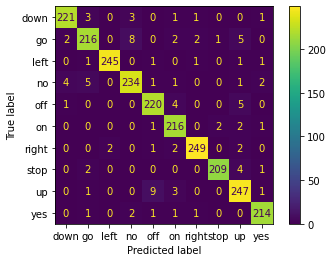
You can download the notebook here or you can run it on Google Colab
Congratulations ! We have discussed and created a Neural Network to classify speech words by using RNN with Pytorch.

Leave a comment